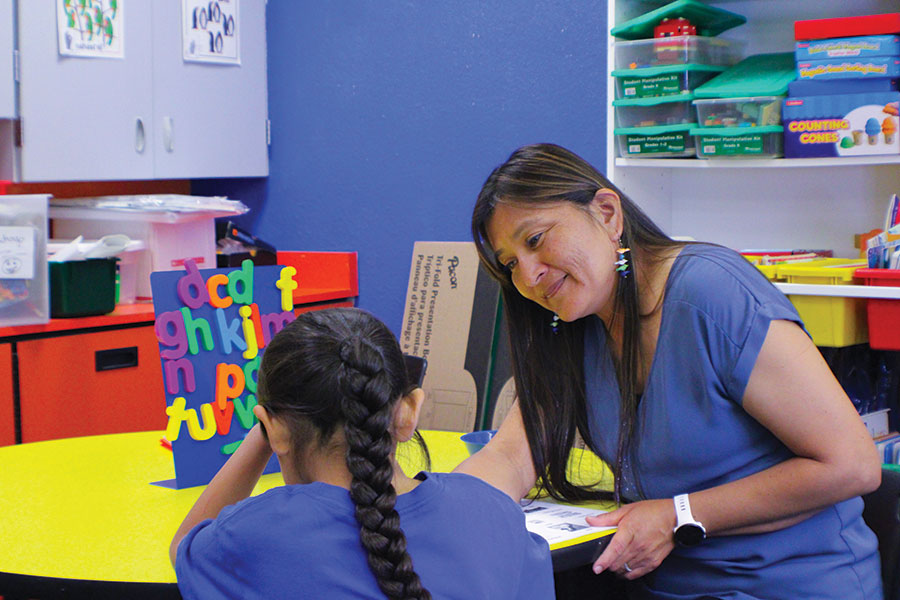With SJC's guide, understand how to become a teacher in NM. Learn about alternative certification for career changers, licensure program options, and more.

Whether you are a first-time college student or a professional considering a career change, New Mexico welcomes future educators from diverse backgrounds with multiple pathways to becoming a certified teacher, including accessible certification programs and flexible options that fit different life circumstances.
This guide will walk you through every step of how to become a teacher in New Mexico, from traditional four-year programs to innovative alternative certification routes, including strategic pathways that can save you time, money, and stress.
Certification Requirements and Timeline
The type of teacher you want to be or the classroom in which you want to teach will impact the specific requirements for certification. Generally, requirements for New Mexico teaching certification include:
- At least a bachelor’s degree from an accredited institution
- Completion of a state-approved teacher education program
- Mentored student teaching practicum
- Potential certification exams or portfolio review
- Fingerprinting and background checks
The New Mexico Public Education Department’s website outlines specific licensure requirements.
Traditional Timeline
Traditional students pursuing their first bachelor’s degree in education generally need four years to complete their program, with student teaching requirements typically falling in the third or fourth years.
Alternative Certification Timeline
If you hold at least a bachelor’s degree in another field, alternative certification programs allow you to start a paid teaching position just months after completing a degree or teacher preparation program in education. Alternative teacher licensure programs may provide two or three-year options.
Community College Timeline
Community college offers a strategic advantage for new or returning students. You can earn an associate’s degree in education in two years, then transfer to complete your bachelor’s and certification. This path reduces costs and often features guaranteed university transfer admission. Transferring prior credits can further shorten the timeline if you have some college but no degree.
Certification Pathways
Traditional Pathway for First-Time Students
New Mexico’s requirements for teacher certification streamline the process for aspiring college students who wish to become teachers. Grasping the process enables you to plan your journey effectively.
1. Choose Your Teaching Level
Select the program that best meets your needs and goals. You’ll choose your preferred grade level, such as early childhood (birth through third grade), elementary, or secondary (grades six-12); classroom type, like special education (PreK-12), and the subject you are most passionate about teaching.
2. Complete Bachelor’s Degree
Complete a four-year bachelor’s degree (or first earn an associate degree and then transfer to a bachelor’s) from a state-approved college or university that provides educator preparation. Along with academic requirements, programs include student teaching hours in elementary education, secondary education subject areas, or special education.
3. Gain Practical Teaching Experience
Once you reach the third or fourth year of your state-approved teacher preparation program, you will complete at least one mentored student teaching experience. You may have opportunities for volunteer or internship experiences before your student teaching semesters.
4. Complete Portfolio Assessment
New Mexico’s innovative approach to teacher certification emphasizes practical skills over standardized testing. Starting in 2024, a comprehensive portfolio assessment will replace most certification exams, requiring submission of evidence of professional development such as lesson plans, student work samples, and lesson recordings.
5. Apply for New Mexico Teaching License
The final administrative step to become a certified teacher in New Mexico is to ensure that your license application is complete and accurate. In addition to the application fee, you will apply through the online NMPED Licensure Portal with required documents such as an official certificate or degree transcripts.
Alternative Pathway for Career Changers
If you have at least a bachelor’s degree in any field, New Mexico’s alternative teacher certification recognizes that excellent teachers come from diverse backgrounds and that real-world expertise enhances classroom instruction.
Step 1. Assess Your Background and Goals
The basic education requirement for certification is a bachelor’s degree, alongside 30 or more semester hours in the teaching subject. Have you completed a bachelor’s degree? A certificate-only program may enable you to earn only the additional credits needed to fulfill the requirements.
Step 2. Enter Your Chosen Alternative Program
Select the best post-baccalaureate alternative licensure program option for you: a certificate, an online program, or a specialized program sponsored by the state or through special partnerships with universities, such as the three-year San Juan College (SJC) Teacher Residency program.
Step 3. Secure Teaching Position or Internship
In an alternative licensure program, you apply for an internship teaching license to begin teaching while completing certification requirements. Your program may assist with placement in a role, allowing you to meet requirements more quickly, apply concepts in real classrooms, and earn a paycheck while you learn.
Step 4. Complete Courses and Mentored Practicum
Throughout the two or three years of the alternative certification process, you will enroll in courses covering education theory, classroom management, and subject-specific teaching strategies, culminating in portfolio development to showcase your teaching competency and success in mentored student teaching.
Step 5. Pursue Full Certification
After completing the approved program, fulfill any remaining requirements, such as state-mandated workshops, and submit your portfolio to transition from the alternative preliminary teaching license to a full Level 1 License.
Securing Your Teaching Position
With your certification complete, you’re ready to launch your teaching career in public schools across New Mexico. You can rely on your college or university’s career services to assist you in finding a job placement, or alternative certification programs often help secure placement before you graduate.
Tip: New Mexico and other states often provide tuition benefits or assistance for commitments to work in specific positions after graduation. Discover more about attending college, including becoming a teacher, for free in New Mexico.
Choosing Your Degree or Certification Program
New Mexico’s flexible certification system accommodates various educational backgrounds and career goals. Understanding various program types and pathways helps you determine the most appropriate route to your teaching career.
Types of Bachelor’s Degrees in Education
For certification, you'll need at least a bachelor’s degree. There are several paths to get there, depending on your educational and career goals. Two main types of bachelor’s degrees are available:
- Bachelor of Arts (BA) in Education: Prepares teachers with courses in the chosen subject area, learning and teaching strategies, child development, and general education, often focusing on the humanities and social sciences.
- Bachelor of Science (BS) in Education: Typically includes more preparation in the sciences, with lab course requirements and a greater focus on mathematics, biology, chemistry, etc.
Alternative Licensure Certificates
If you already have a bachelor’s degree, you can start on the path to becoming a teacher through New Mexico's alternative licensure program. These post-baccalaureate programs build on your existing education to focus on teaching methods, child development, and educational research. Choose a certificate:
- Approved by the state to prepare for certification
- In elementary, secondary, or special education
- With assistance in earning a provisional teaching license to begin teaching.
Types of Subject Areas
There are generally two categories of subject areas for teacher education programs in New Mexico: a major focused on the student level (such as early elementary or secondary education) and a major in a subject area that includes a teacher preparation sequence.
Preparation level majors:
- Early Childhood Education (birth through third grade)
- Elementary Education (kindergarten through fifth grade)
- Secondary Education (sixth through twelfth grades)
- Special Education (all grades)
Subject area majors:
- STEM fields: Mathematics, Science, Math Education, Science Education
- Humanities/social sciences: Art, English, Social Studies, History
- Specialized Programs: Bilingual Education, Special Education
Benefits of Starting with an Associate Degree
Associate degrees provide an excellent foundation for those seeking a bachelor’s degree, offering strategic advantages that make this the smartest route for many aspiring educators. This pathway combines affordability, quality instruction, and personalized support while preparing you for transfer to a bachelor’s degree program.
- Cost-effective: Complete general education and intro courses at significantly lower tuition rates.
- Unique community resources: Community colleges with associate degrees foster local district and community connections for internship or job placement.
- Transfer agreements: Guaranteed admission agreements prevent lost credits and provide certainty with program and certification requirements.
San Juan College partners with Western New Mexico University (WNMU) to ensure a seamless transfer to their bachelor’s degree in education, allowing students to complete both degrees in Farmington. Learn about the TeachUp program and other transfer agreements available for SJC students.
Understanding New Mexico’s Teaching License Levels
After obtaining your first teaching license, there are additional levels you can pursue to enhance your knowledge, skills, and career potential:
- Level 1 License: Entry point for new teachers (five-year validity)
- Level 2 License: Requires demonstrated teaching competency and three years of classroom experience (nine-year validity)
- Level 3A License: Can be pursued after three years of Level 2 licensure and meeting other requirements, such as earning an additional microcredential.
Start Your Teaching Journey at San Juan College
San Juan College offers an outstanding foundation for your teaching career, no matter your professional background, flexibility requirements, or previous education. Our Associate of Arts (AA) degree and alternative licensure certificate programs serve students interested in early childhood education, elementary and special education, and secondary education across multiple subject areas.
Ready to start your rewarding career in education? Contact us today to learn more about our approved New Mexico teacher preparation programs and discover how you can efficiently and affordably achieve your goals.



